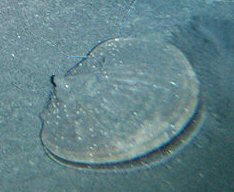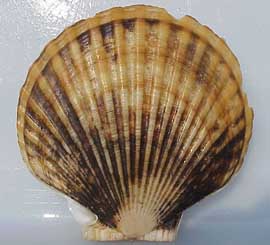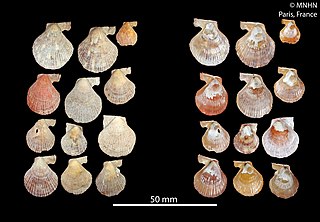
The Cambrian Period is the first geological period of the Paleozoic Era, and of the Phanerozoic Eon. The Cambrian lasted 53.4 million years from the end of the preceding Ediacaran Period 538.8 million years ago (mya) to the beginning of the Ordovician Period 485.4 mya. Its subdivisions, and its base, are somewhat in flux.

The Ediacaran period is a geological period of the Neoproterozoic era that spans 96 million years from the end of the Cryogenian period at 635 Mya, to the beginning of the Cambrian period at 538.8 Mya. It is the last period of the Proterozoic eon as well as the last of the so-called "Precambrian supereon", before the beginning of the subsequent Cambrian period marks the start of the Phanerozoic eon where recognizable fossil evidence of life becomes common.

Scallop is a common name that encompasses various species of marine bivalve mollusks in the taxonomic family Pectinidae, the scallops. However, the common name "scallop" is also sometimes applied to species in other closely related families within the superfamily Pectinoidea, which also includes the thorny oysters.

Nodipecten is a genus of large scallops, marine bivalve molluscs in the family Pectinidae, the scallops. These scallops often have attractive, strongly colored, thick shells. The generic name Nodipecten means "nodular scallop", because in this genus the shell is usually sculpted with regular, very large nodes.

Aequipecten is a genus of scallops, marine bivalve mollusks in the family Pectinidae.

Chlamys is a genus of small scallops, marine bivalve molluscs in the family Pectinidae. The name is taken from the Ancient Greek, χλαμΰς or Chlamys, a cloak worn by soldiers.

Talochlamys zelandiae, common name the fan shell, is a species of marine bivalve mollusc in the scallop family Pectinidae.

The Pectinoidea are a superfamily of marine bivalve molluscs, including the scallops and spiny oysters.

Euvola is a genus of marine bivalve mollusks in the family Pectinidae, the scallops. In shells of this genus, one valve is flat, and the other is deeply cupped.

Propeamussium is a genus of saltwater clams, marine bivalve mollusks in the order Ostreoida.

Mimachlamys is a genus of scallops, marine bivalve molluscs in the taxonomic family Pectinidae. There are at least 11 living species, including the glory scallop Mimachlamys gloriosa, and the Mimachlamys asperrima.

Gigantopecten is a genus of fossil scallops, marine bivalve molluscs in the family Pectinidae, the scallops.
Spondylus ostreoides is a species of spiny oyster. It was only found once, off Raoul Island in the South Pacific Ocean.

Mizuhopecten is a genus of bivalves belonging to the family Pectinidae.
Leptopecten is a genus of bivalves belonging to the family Pectinidae.

Adamussium is a genus of scallops belonging to the family Pectenidae from the Southern Ocean around Antarctica. There are three known species but only one is extant, the Antarctic scallop. Of the two extinct species A. jonkersi is from the Oligocene deposits on King George Island in the South Shetland Islands and the other, A. necopinatum, was described in 2016 from Pliocene marine deposits in the Vestfold Hills of East Antarctica.

Patinopecten is a genus of bivalves belonging to the family Pectinidae.

Scaeochlamys is a genus of bivalves belonging to subfamily Pedinae of the family Pectinidae.

Semipallium is a genus of bivalves belonging to subfamily Pedinae of the family Pectinidae.

Spathochlamys is a genus of scallops, marine bivalve molluscs in the taxonomic subfamily Pedinae of the family Pectinidae.


















